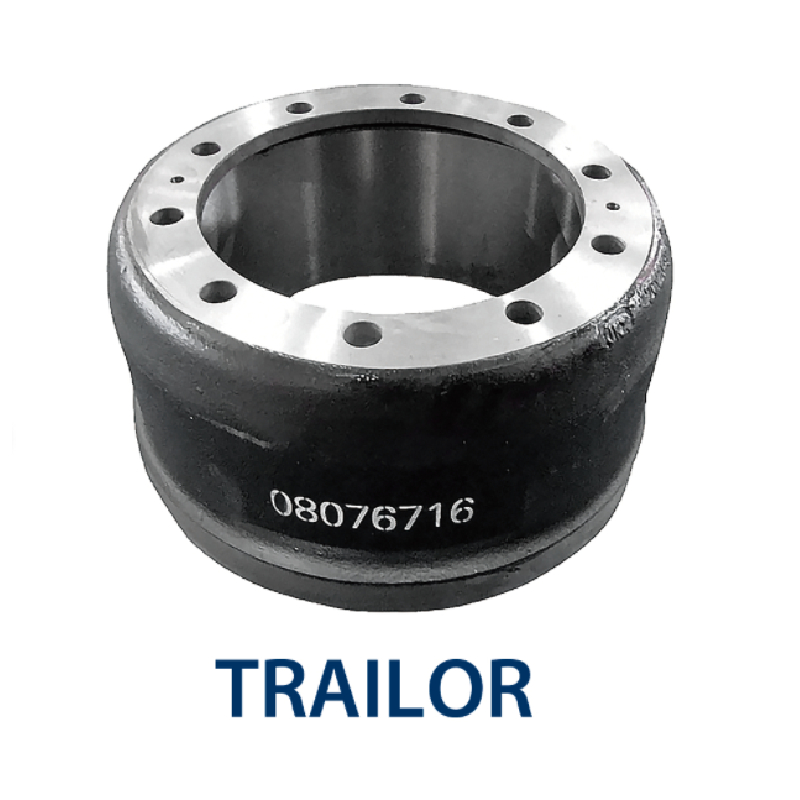Sult . 29, 2024 03:18 Back to list
Understanding the Manufacturing Process of Brake Drums in Automotive Industry
Brake Drum Manufacturing Process
Brake drums are critical components in the braking systems of vehicles, playing a vital role in ensuring safety and efficiency. Their primary function is to absorb kinetic energy and convert it into heat through friction when the brake shoes press against the drum. The manufacturing process of brake drums involves several intricate steps, requiring careful attention to material selection, machining, and quality control to ensure performance and durability.
1. Material Selection
The manufacturing of brake drums typically starts with material selection. The most commonly used materials are cast iron and aluminum alloys. Cast iron is favored for its excellent wear resistance, ability to dissipate heat, and cost-effectiveness. Aluminum, while lighter, is often used in high-performance or specialized applications where weight savings are crucial. The choice of material influences the performance characteristics of the brake drum, its lifespan, and its ability to withstand extreme temperatures during braking.
2. Melting and Casting
Once the material is selected, the next step is melting. For cast iron brake drums, scrap iron, along with alloying elements, is placed in a furnace and heated until it reaches a molten state. This process requires precise temperature control to ensure uniformity in the material.
After melting, the molten iron is poured into molds that define the shape and size of the brake drums. The molds are typically made from sand or metal and are designed to withstand the heat of the molten metal. Once poured, the molten metal is allowed to cool and solidify. After cooling, the molds are removed, revealing the rough cast brake drums.
3. Machining
While the cast brake drums have taken shape, they are not yet ready for use
. The next crucial step is machining. This involves several processes, including turning, milling, and grinding, to achieve the precise dimensions and smooth surface finish required for optimal performance.During turning, the excess material is removed from the brake drum to ensure that it is symmetrical and properly sized. Milling may be used to create keyways or other features needed for assembly. Finally, grinding is conducted to produce a smooth, even surface that minimizes friction and wear between the brake drum and the brake shoes. This step is essential for effective heat dissipation during braking.
brake drum manufacturing process

4. Heat Treatment
After machining, the brake drums undergo heat treatment to enhance their mechanical properties. This process involves heating the drums to a specific temperature and then cooling them rapidly. Heat treatment improves the strength and durability of the brake drums, making them more resistant to deformation and wear. The appropriate heat treatment process varies depending on the material used but is crucial for ensuring reliable performance under high-stress conditions.
5. Surface Finishing
Surface finishing is an important step in brake drum manufacturing. The drums are often painted or coated to prevent corrosion and enhance their appearance. The coating also serves as a barrier to environmental factors that could potentially degrade the material over time. In addition, non-skid surfaces may be applied to improve the friction characteristics of the brake drums.
6. Quality Control
Quality control is a critical aspect of the manufacturing process. Every batch of brake drums undergoes rigorous testing to ensure they meet the industry's safety and performance standards. This includes dimensional checks, material testing, and performance evaluations under simulated braking conditions. Non-destructive testing methods may also be employed to detect any internal flaws that could compromise the drum's integrity.
7. Packaging and Distribution
Once the brake drums have passed quality inspections, they are cleaned, packaged, and prepared for distribution. Proper packaging is essential to prevent damage during transport and ensure that the products reach customers in optimal condition.
Conclusion
The manufacturing process of brake drums is a complex interplay of material science, engineering, and quality assurance. Each step, from material selection to final inspection, ensures that these critical components provide reliable performance and safety in braking systems. As automotive technology continues to evolve, manufacturers must adapt and innovate to meet the demands for improved performance, efficiency, and sustainability, underscoring the importance of continuous improvement in brake drum manufacturing processes.
-
Brake Drum Liza Durable & High-Performance Brake Solutions
NewsMay.29,2025
-
Brake Drum Liza Durable Drum Brake & Shoe Replacement Solutions
NewsMay.29,2025
-
Brake Drum Liza High-Quality Drum Brake & Shoe Solutions
NewsMay.29,2025
-
Brake Drum Liza Durable Drum Brake & Shoe Solutions for Vehicles
NewsMay.29,2025
-
Brake Drum Liza Premium Drum Brake Components & Shoes
NewsMay.29,2025
-
Brake Drum Man Durable Drum Brake Drums & Shoes Supplier
NewsMay.28,2025
